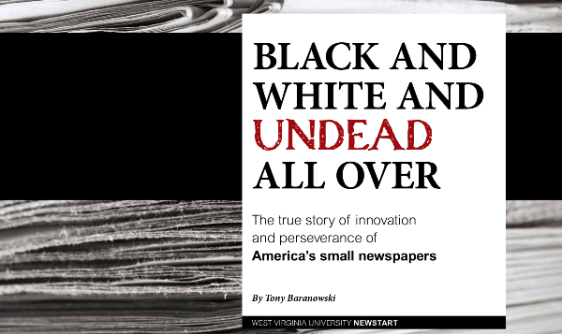
Black and White and Undead All Over
September 15, 2021
Welcome to a special edition of The NewStart Alliance. This week I’m turning things over to recent NewStart grad Tony Baranowski who, as part of his yearlong master’s degree program, took a deep dive into what’s working at rural community newspapers across the Midwest.
What you are about to read doesn’t match up with the national narrative you’ve come to know and (perhaps) believe about newspapers across the country. Tony found a much different outlook and numerous stories that needed to be told. So with that being said, I turn it over to Tony to provide the rest of the story.
I’m so tired of hearing newspapers are dying. My entire career, approaching 25 years now, that’s been the dominant narrative in the business. Even I believed it for a time and clearly many still do.
But there’s a delineation to be made between those that have struggled mightily or even folded and those that are going strong. It’s a tough argument to make because, like any other misinformation battle in this era, the myth has been repeated so often by so many influential media people, when someone who works for a tiny weekly in Iowa says otherwise, we’re dismissed as an aberration.
But we’re not an aberration. On the heels of my year in the NewStart program in Media Solutions and Innovation, I polled and visited with a number of successful community news organizations across the country with a focus on my backyard, the upper Midwest. What I found affirmed what I’ve come to realize through the second half of my career.
Community papers face challenges, but most of them aren’t going anywhere. They are the foundation for not only the storylines and coverage you see go national, but for the business practices and defiance of the “newspapers are dying” portrayal. Small outlets still have the faith of their readers and loyalty of their customers.
Community newspapering is both the past and the future of the best, most important journalism in America.
Tony Baranowski
Director of Local Media for Times Citizen Communications, Iowa Falls, Iowa
[email protected]; @tonyapb3
The following excerpt is from Tony’s full report. Because space is limited in this newsletter, you can read the entire report online or download it here.

The strongest community news outlets are locally owned and managed by families or individuals with local ties that stretch back decades. That’s not an easy circumstance to replicate for a would-be publisher looking to buy or launch a news organization in a rural town, but it’s not a prerequisite, either. In fact, the common denominator is less longevity than fostering community spirit and pride within both staff-generated content and advertising in a traditional newspaper’s pages.
Jim Slonoff and his team launched The Hinsdalean in an affluent Chicago suburb in 2006 after more than two decades working for a chain that fell victim to corporate buyouts. They parlayed the buyout money into a simple business plan that yielded quick results, both in terms of acceptance and financial success. The Hinsdalean is distributed free to every household in its circulation area with little attention to online presence, which is also freely accessible.
“It was amazing to us when we opened up our office here because we were right downtown,” said Slonoff. “People walk in our door, people bring us stories or, if we’re lucky, people bring us cookies. It’s everything you dream it would be. The fact of just getting the paper in people’s hands has really contributed a lot to our success. We’re the face of the newspaper as well as the owners. In our situation with our community… a strong local newspaper is something that people wanted and embraced faster than we thought.”
Central to the local mission of the most successful small newspapers is an observable local presence. Small newspaper chains in Iowa, Nebraska, Minnesota, Illinois and Wisconsin all echoed this core belief in interviews. Julie Bergman dropped out of college and bought her first newspaper in Baudette, Minnesota, at 19. Thirty-five years later that same paper remains the flagship of Page 1 Publications, which she runs with husband Rollin. Page 1 quickly added banners under Bergman, but she remained committed to maintaining an office in each of their communities.
“We do have an office in each community, we feel strongly that that presence is needed,” Bergman said. “Each one is staffed by an average of two full-time people and each of those people are local. In fact, almost without exception, they’ve all grown up in the communities where they’re running the papers.”
It’s antithetical to the strategy of many corporate chains and even smaller publishers that have sacrificed local presence in an effort to cut expenses.
Kurt Johnson grew up as part of a Nebraska newspapering family and considers the Nebraska Press Association part of his extended family. Johnson left the family operation to get a journalism degree and build on his background with experience as a managing editor and executive editor at dailies. When the opportunity arose to buy the Aurora News-Register in 2000, Johnson pounced on a return to community newspapering.
“I just kind of jumped in and engaged like I had in previous roles, being involved with economic development and just being very much part of the community. We devoted space to a local business page, which really tuned me into new businesses and what’s happening in the community, which was good for the newspaper,” Johnson explained.
Now 58, Johnson has begun to consider what an exit strategy might look like and says there’s no shortage of corporate suitors. But if they aren’t dedicated to journalism, he doesn’t take the call.
“There’s a lot of money out there, but if it’s somebody that just looks at it as an investment, they [downsize] the newsroom, nobody lives there local and within a year or so you’ve got issues. Particularly if you (as the former publisher) continue to live there. That can be just a really tough scenario. So I would prefer not to go down that path.”
That doesn’t mean, however, that there aren’t efficiencies to be identified within a small publishing company, or even partnerships with neighboring communities. Most of the group publishers interviewed for this project have centralized bookkeeping, design and layout, and in some cases shared advertising sales representatives to keep overhead low. Others coordinate print schedules with fellow publishers to share transportation expenses and time on the road.
Wayward or defunct newspapers aren’t the only hub of community activities that have, at times, lost sight of building real life connections in favor of convenience and technology. Jeff Wagner helms one of the most revered newspaper companies in Iowa, Iowa Information, and its companion printing company, White Wolf Web. He says newspapers have to take the lead on community building because without those tactile relationships, the communities themselves will fail.
“One of the stupidest things school districts are doing is allowing their athletic events to be broadcast online,” said Wagner. “Because when I go to a basketball game, or football game or whatever, I create a connection with the school district, I create a connection with my neighbors. But if I can sit at home, I really don’t know what condition the school’s in, I don’t care if they get new bleachers, I stop wanting to pass tax levies for my school district, because I have no connection with the school district.”
Bergman calls the basic human need for a dependable local news source “the big pumpkin theory.”
“They can get their national information and their statewide information from many different sources. Who else is going to run the picture of the big pumpkin their neighbor grew that they can talk about over coffee? I’m not making fun of that! I think that’s an important kind of feature news that makes a person and people feel a part of a place. And that’s why I’m so bullish on community newspapers, whatever form or shape they take.”
As mentioned earlier, this is an excerpt of Tony’s in-depth report. You can read all of it at the links below, and keep an eye out for a conversation that Tony had with Poynter’s Kristen Hare that will be published on poynter.org.
